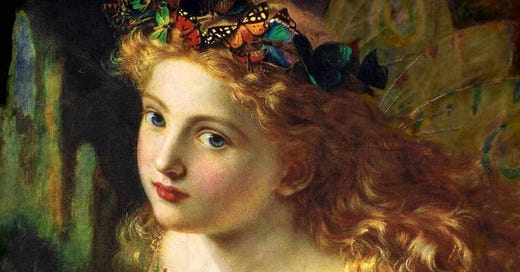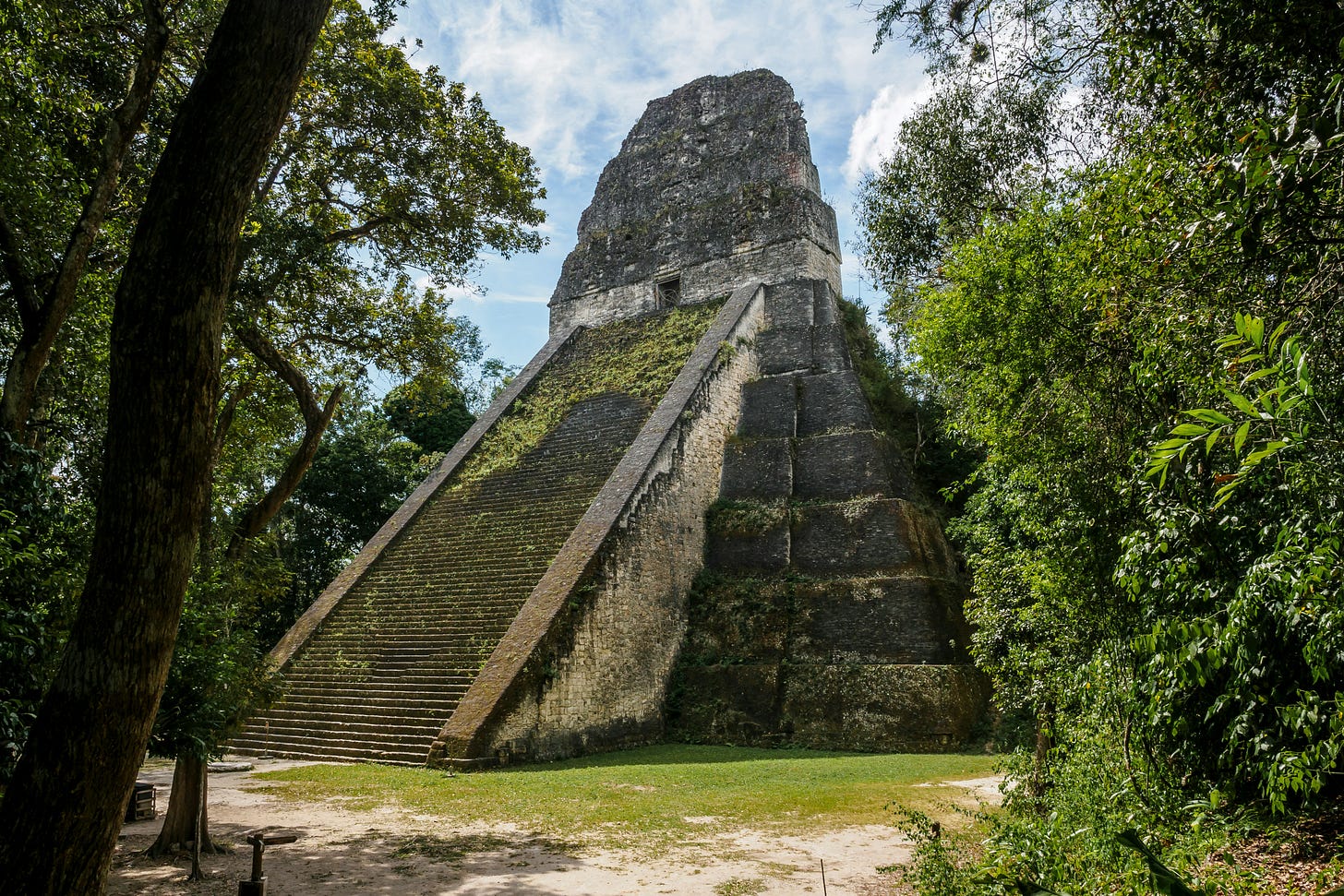Thursday Things is here! This week we dance around the maypole, and may meet the Maya.
If you enjoy this edition, please click the heart icon in the header or at the end of the post to let me know.
It’s just a spring clean for the May Queen. Image: ‘Take the Fair Face of Woman, and Gently Suspending, With Butterflies, Flowers, and Jewels Attending, Thus Your Fairy is Made of Most Beautiful Thing’ Sophie Anderson (1869)
Maypole madness
It’s May 1st, the traditional date various traditional festivals and celebrations that may or may not involve some kind of creepy lottery1 but almost certainly involves a maypole.
We’ve all heard about dancing around the maypole — but what is that exactly? Let’s find out! Britannica tells us:
Maypole dance, ceremonial folk dance performed around a tall pole garlanded with greenery or flowers and often hung with ribbons that are woven into complex patterns by the dancers. Such dances are survivals of ancient dances around a living tree as part of spring rites to ensure fertility. Typically performed on May Day (May 1), they also occur at midsummer in Scandinavia and at other festivals elsewhere.
But this shoe company (?) website2 has more detail:
The origins of the maypole are as interwoven and fluid as the dancing it inspires. Early evidence traces the tradition back to Pagan May 1st festivals across Europe. This celebration was called “Beltane” in the regions later known as England and Ireland, and “Walpurgis” in Germanic areas. In some areas, Roman influences also helped shape the celebrations, introducing elements from the spring Festival of Floralia (the goddess of flowers) to these Wiccan and Druidic ceremonies.
I knew it! Pagan druid Beltane stuff. Here’s my advice — if you happen to wander into some isolated rural town in the English and/or New England countryside today to join the local maypole dance, sure, great, have fun. Just don’t buy a lottery ticket or fall for the old “would you like to see the Wicker Man?” routine.
As for the dance itself, it may seem harmless, but the authorities have at times gone full Footloose on it:
In an effort to discourage nature idolatry and feminine sexuality, many Christian clergy fought to end these May Day customs, and all maypoles were made illegal in England from 1644 to 1660. The tradition bounced back quickly, however, although in a more playful, child-centric form significantly removed from its mystic roots. In fact, in many Western countries, maypole dances were made an official part of the physical education curriculum for young girls from the late 1800s through the 1940s.
For those not up on their English history, 1644-1660 was the Commonwealth era, when Oliver Cromwell and the Puritans were in charge. In addition to maypole dances, they shut down stage plays, card playing, and King Charles I keeping his head. Puritans gonna Puritan.
But the party got started again when Charles II aka “The Merry Monarch” reclaimed the throne.
Here is a more authoritative source of information about traditional May Day celebrations:
Many folklore customs have their roots planted firmly back in the Dark Ages, when the ancient Celts had divided their year by four major festivals. Beltane or ‘the fire of Bel’, had particular significance to the Celts as it represented the first day of summer and was celebrated with bonfires to welcome in the new season. Still celebrated today, we perhaps know Beltane better as May 1st, or May Day.
Down through the centuries May Day has been associated with fun, revelry and perhaps most important of all, fertility. The Day would be marked with village folk cavorting round the maypole, the selection of the May Queen and the dancing figure of the Jack-in-the-Green at the head of the procession. Jack is thought to be a relic from those enlightened days when our ancient ancestors worshipped trees.
And, in all fairness to the Puritans, they weren’t the only ones banning the May Day fun:
These pagan roots did little to endear these May Day festivities with the either the established Church or State. In the sixteenth century riots followed when May Day celebrations were banned. Fourteen rioters were hanged, and Henry VIII is said to have pardoned a further 400 who had been sentenced to death.
Riots are also a traditional English activity, it seems.
More information via the perfume encyclopedia Fragrantica, because why not?
The First of Summer: Floris of London Celebrates Beltane
You can dance if you want to:
Tikal surprise
You never know what you’ll find digging around in the rain forests of Central America.
Rewriting Mayan History: Archaeologists Discover Hidden Altar Buried Underground
Buried underground? One wonders where else things can be buried than underground.
Anyway:
A newly discovered altar buried near the center of the ancient Maya city of Tikal is providing fresh insight into the 1,600-year-old tensions between Tikal and the central Mexican capital of Teotihuacan.
East side vs. west side is not just for street gangs and rappers, it seems.
Just steps from the center of Tikal, a 2,400-year-old Maya city in present-day Guatemala, a team of international researchers, including scholars from Brown University, has uncovered a buried altar that may help explain a period of major upheaval in the ancient world.
That’s a very helpful altar!
The altar, dating to the late 300s A.D., features four painted panels in red, black, and yellow. These depict a figure wearing a feathered headdress and flanked by what appear to be shields or ceremonial items. The figure’s face has almond-shaped eyes, a nose bar, and a double earspool, closely resembling images of the “Storm God,” a deity known from central Mexico.
Okay … but what is this telling us?
In a study published in Antiquity, the Brown researchers and their collaborators from the United States and Guatemala suggest that the altar was likely not created by a Maya artist. Instead, they argue it was crafted by a highly skilled artisan trained in Teotihuacan, the powerful ancient city located 630 miles to the west near modern-day Mexico City.
Aha! The plot thickens.
“It’s increasingly clear that this was an extraordinary period of turbulence at Tikal,” said Stephen Houston, a professor of social science, anthropology, and history of art and architecture at Brown, who co-authored the paper. “What the altar confirms is that wealthy leaders from Teotihuacan came to Tikal and created replicas of ritual facilities that would have existed in their home city. It shows Teotihuacan left a heavy imprint there.”
Sounds like somebody got themselves conquered.
Founded in about 850 B.C., Tikal existed for generations as a small city with little influence before ballooning into a dynasty around 100 A.D. Archaeologists have evidence that Tikal and the much more powerful Teotihuacan began interacting regularly about two centuries later. What seemed at first to be a casual trading relationship, Houston said, quickly became something more contentious.
“It’s almost as if Tikal poked the beast and got too much attention from Teotihuacan,” Houston said. “That’s when foreigners started moving into the area.”
That problem sounds vaguely familiar.
It’s pretty much all of human history.
Thanks to the stone’s text, they learned that “around A.D. 378, Teotihuacan was essentially decapitating a kingdom,” Houston said. “They removed the king and replaced him with a quisling, a puppet king who proved a useful local instrument to Teotihuacan.”
Bingo!
Teotihuacan was the capital of the empire we today call the Aztec. It seems their reach extended to Tikal for a while. Later, when they left, the Maya buried the foreign temple and forgot about it until our intrepid explorers dug it up.
“Everyone knows what happened to the Aztec civilization after the Spanish arrived,” Houston said. “Our findings show evidence that that’s a tale as old as time. These powers of central Mexico reached into the Maya world because they saw it as a place of extraordinary wealth, of special feathers from tropical birds, jade, and chocolate. As far as Teotihuacan was concerned, it was the land of milk and honey.”
Sound like it was the land of taking the Maya’s lunch money.
Get all the archaeological details here: A Teotihuacan altar at Tikal, Guatemala: central Mexican ritual and elite interaction in the Maya Lowlands
Here’s the altar and an artist's rendering of what it may have looked like back in the day. Image: photograph by E. Román; rendering by H. Hurst via Cambridge University Press Antiquity.
Temple V, Tikal, Petén Department - Guatemala Photo by Alexander Schimmeck on Unsplash
This week’s edition is brought to you by Dan’s Advice: Take control of your digital life.
Thank you for reading!
Please click the hearts, leave a comment, and use the share feature to send this issue to a friend who might enjoy it. See you next Thursday!
‘The Lottery’ is actually set in June, at the summer solstice, but same vibe.
Is an Oregon shoe company in an authoritative source for information about traditional European folklore and customs? Probably not. But I love finding tidbits of (possibly dubious) information in oddball places. Anyway, “barefoot shoes” handmade by (I can only assume) capitalistic hippies in Oregon somehow seems like the perfect footgear for all your outdoor pagan dance ritual needs.






